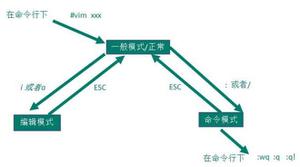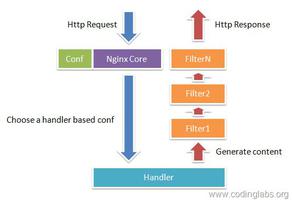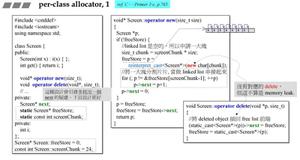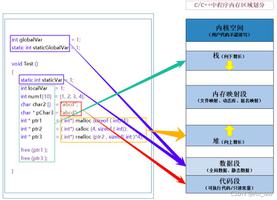Linux内存管理(7)VMA操作【转】 [操作系统入门]

转自:https://www.cnblogs.com/arnoldlu/p/8329279.html
专题:Linux内存管理专题
关键词:VMA、vm_area_struct、查找/插入/合并VMA、红黑树。
用户进程可以拥有3GB大小的空间,远大于物理内存,那么这些用户进程的虚拟地址空间是如何管理的呢?
malloc()或mmap()操作都会要求在虚拟地址空间中分配内存块,但这些内存在物理上往往都是离散的。
这些进程地址空间在内核中使用struct vm_area_struct数据结构来描述,简称VMA,也被称为进程地址空间或进程线性区。
1. 数据结构
struct vm_area_struct可以说是VMA的描述符,在创建之后会插入到mm->mm_rb红黑树和mm->mmap链表中。
/* * This struct defines a memory VMM memory area. There is one of these
* per VM-area/task. A VM area is any part of the process virtual memory
* space that has a special rule for the page-fault handlers (ie a shared
* library, the executable area etc).
*/
struct vm_area_struct {
/* The first cache line has the info for VMA tree walking. */
unsigned long vm_start; /* Our start address within vm_mm. */--------VMA在进程地址空间的起始结束地址
unsigned long vm_end; /* The first byte after our end address
within vm_mm. */
/* linked list of VM areas per task, sorted by address */
struct vm_area_struct *vm_next, *vm_prev;----------------------------------VMA链表的前后成员
struct rb_node vm_rb;------------------------------------------------------VMA作为一个节点加入到红黑树中,每个进程的mm_struct中都有一个红黑树mm->mm_rb。
/*
* Largest free memory gap in bytes to the left of this VMA.
* Either between this VMA and vma->vm_prev, or between one of the
* VMAs below us in the VMA rbtree and its ->vm_prev. This helps
* get_unmapped_area find a free area of the right size.
*/
unsigned long rb_subtree_gap;
/* Second cache line starts here. */
struct mm_struct *vm_mm; /* The address space we belong to. */--------指向VMA所属进程的struct mm_struct结构。
pgprot_t vm_page_prot; /* Access permissions of this VMA. */------VMA访问权限
unsigned long vm_flags; /* Flags, see mm.h. */--------------------VMA标志位
/*
* For areas with an address space and backing store,
* linkage into the address_space->i_mmap interval tree.
*/
struct {
struct rb_node rb;
unsigned long rb_subtree_last;
} shared;
/*
* A file‘s MAP_PRIVATE vma can be in both i_mmap tree and anon_vma
* list, after a COW of one of the file pages. A MAP_SHARED vma
* can only be in the i_mmap tree. An anonymous MAP_PRIVATE, stack
* or brk vma (with NULL file) can only be in an anon_vma list.
*/
struct list_head anon_vma_chain; /* Serialized by mmap_sem &-----------用于管理RMAP反向映射。
* page_table_lock */
struct anon_vma *anon_vma; /* Serialized by page_table_lock */------用于管理RMAP反向映射。
/* Function pointers to deal with this struct. */
const struct vm_operations_struct *vm_ops;-----------------------------VMA操作函数合集,常用于文件映射。
/* Information about our backing store: */
unsigned long vm_pgoff; /* Offset (within vm_file) in PAGE_SIZE-指定文件映射的偏移量,单位是页面。
units, *not* PAGE_CACHE_SIZE */
struct file * vm_file; /* File we map to (can be NULL). */------描述一个被映射的文件。
void * vm_private_data; /* was vm_pte (shared mem) */
#ifndef CONFIG_MMU
struct vm_region *vm_region; /* NOMMU mapping region */
#endif
#ifdef CONFIG_NUMA
struct mempolicy *vm_policy; /* NUMA policy for the VMA */
#endif
}
struct mm_struct是描述进程内存管理的核心数据结构,VMA属于进程内存区域。在mm_struct中通过mmap链表和mm_rb对vm_area_struct进行管理。
struct mm_struct {struct vm_area_struct *mmap; /* list of VMAs */-----单链表,按起始地址递增的方式插入,所有的VMA都连接到此链表中。链表头是mm_struct->mmap。
struct rb_root mm_rb;--------------------------------------所有的VMA按照地址插入mm_struct->mm_rb红黑树中,mm_struct->mm_rb是根节点,每个进程都有一个红黑树。
...
}
2. 查找VMA
/* Look up the first VMA which satisfies addr < vm_end, NULL if none. */struct vm_area_struct *find_vma(struct mm_struct *mm, unsigned long addr)
{
struct rb_node *rb_node;
struct vm_area_struct *vma;
/* Check the cache first. */
vma = vmacache_find(mm, addr);
if (likely(vma))
return vma;
rb_node = mm->mm_rb.rb_node;
vma = NULL;
while (rb_node) {
struct vm_area_struct *tmp;
tmp = rb_entry(rb_node, struct vm_area_struct, vm_rb);
if (tmp->vm_end > addr) {
vma = tmp;
if (tmp->vm_start <= addr)
break;
rb_node = rb_node->rb_left;
} else
rb_node = rb_node->rb_right;
}
if (vma)
vmacache_update(addr, vma);
return vma;
}
struct vm_area_struct *vmacache_find(struct mm_struct *mm, unsigned long addr)
{
int i;
if (!vmacache_valid(mm))
return NULL;
count_vm_vmacache_event(VMACACHE_FIND_CALLS);
for (i = 0; i < VMACACHE_SIZE; i++) {
struct vm_area_struct *vma = current->vmacache[i];
if (!vma)
continue;
if (WARN_ON_ONCE(vma->vm_mm != mm))
break;
if (vma->vm_start <= addr && vma->vm_end > addr) {
count_vm_vmacache_event(VMACACHE_FIND_HITS);
return vma;
}
}
return NULL;
}
void vmacache_update(unsigned long addr, struct vm_area_struct *newvma)
{
if (vmacache_valid_mm(newvma->vm_mm))
current->vmacache[VMACACHE_HASH(addr)] = newvma;
}
3. 插入VMA
int insert_vm_struct(struct mm_struct *mm, struct vm_area_struct *vma){
struct vm_area_struct *prev;
struct rb_node **rb_link, *rb_parent;
/*
* The vm_pgoff of a purely anonymous vma should be irrelevant
* until its first write fault, when page‘s anon_vma and index
* are set. But now set the vm_pgoff it will almost certainly
* end up with (unless mremap moves it elsewhere before that
* first wfault), so /proc/pid/maps tells a consistent story.
*
* By setting it to reflect the virtual start address of the
* vma, merges and splits can happen in a seamless way, just
* using the existing file pgoff checks and manipulations.
* Similarly in do_mmap_pgoff and in do_brk.
*/
if (!vma->vm_file) {
BUG_ON(vma->anon_vma);
vma->vm_pgoff = vma->vm_start >> PAGE_SHIFT;
}
if (find_vma_links(mm, vma->vm_start, vma->vm_end,
&prev, &rb_link, &rb_parent))
return -ENOMEM;
if ((vma->vm_flags & VM_ACCOUNT) &&
security_vm_enough_memory_mm(mm, vma_pages(vma)))
return -ENOMEM;
vma_link(mm, vma, prev, rb_link, rb_parent);
return 0;
}
static int find_vma_links(struct mm_struct *mm, unsigned long addr, unsigned long end, struct vm_area_struct **pprev,
struct rb_node ***rb_link, struct rb_node **rb_parent)
{
struct rb_node **__rb_link, *__rb_parent, *rb_prev;
__rb_link = &mm->mm_rb.rb_node;
rb_prev = __rb_parent = NULL;
while (*__rb_link) {
struct vm_area_struct *vma_tmp;
__rb_parent = *__rb_link;
vma_tmp = rb_entry(__rb_parent, struct vm_area_struct, vm_rb);
if (vma_tmp->vm_end > addr) {
/* Fail if an existing vma overlaps the area */
if (vma_tmp->vm_start < end)
return -ENOMEM;
__rb_link = &__rb_parent->rb_left;
} else {
rb_prev = __rb_parent;
__rb_link = &__rb_parent->rb_right;
}
}
*pprev = NULL;
if (rb_prev)
*pprev = rb_entry(rb_prev, struct vm_area_struct, vm_rb);
*rb_link = __rb_link;
*rb_parent = __rb_parent;
return 0;
}
static void vma_link(struct mm_struct *mm, struct vm_area_struct *vma,struct vm_area_struct *prev, struct rb_node **rb_link,
struct rb_node *rb_parent)
{
struct address_space *mapping = NULL;
if (vma->vm_file) {
mapping = vma->vm_file->f_mapping;
i_mmap_lock_write(mapping);
}
__vma_link(mm, vma, prev, rb_link, rb_parent);
__vma_link_file(vma);
if (mapping)
i_mmap_unlock_write(mapping);
mm->map_count++;
validate_mm(mm);
}
4. 合并VMA
/* * Given a mapping request (addr,end,vm_flags,file,pgoff), figure out
* whether that can be merged with its predecessor or its successor.
* Or both (it neatly fills a hole).
*
* In most cases - when called for mmap, brk or mremap - [addr,end) is
* certain not to be mapped by the time vma_merge is called; but when
* called for mprotect, it is certain to be already mapped (either at
* an offset within prev, or at the start of next), and the flags of
* this area are about to be changed to vm_flags - and the no-change
* case has already been eliminated.
*
* The following mprotect cases have to be considered, where AAAA is
* the area passed down from mprotect_fixup, never extending beyond one
* vma, PPPPPP is the prev vma specified, and NNNNNN the next vma after:
*
* AAAA AAAA AAAA AAAA
* PPPPPPNNNNNN PPPPPPNNNNNN PPPPPPNNNNNN PPPPNNNNXXXX
* cannot merge might become might become might become
* PPNNNNNNNNNN PPPPPPPPPPNN PPPPPPPPPPPP 6 or
* mmap, brk or case 4 below case 5 below PPPPPPPPXXXX 7 or
* mremap move: PPPPNNNNNNNN 8
* AAAA
* PPPP NNNN PPPPPPPPPPPP PPPPPPPPNNNN PPPPNNNNNNNN
* might become case 1 below case 2 below case 3 below
*
* Odd one out? Case 8, because it extends NNNN but needs flags of XXXX:
* mprotect_fixup updates vm_flags & vm_page_prot on successful return.
*/
struct vm_area_struct *vma_merge(struct mm_struct *mm,
struct vm_area_struct *prev, unsigned long addr,
unsigned long end, unsigned long vm_flags,
struct anon_vma *anon_vma, struct file *file,
pgoff_t pgoff, struct mempolicy *policy)
{
pgoff_t pglen = (end - addr) >> PAGE_SHIFT;
struct vm_area_struct *area, *next;
int err;
/*
* We later require that vma->vm_flags == vm_flags,
* so this tests vma->vm_flags & VM_SPECIAL, too.
*/
if (vm_flags & VM_SPECIAL)
return NULL;
if (prev)
next = prev->vm_next;
else
next = mm->mmap;
area = next;
if (next && next->vm_end == end) /* cases 6, 7, 8 */
next = next->vm_next;
/*
* Can it merge with the predecessor?
*/
if (prev && prev->vm_end == addr &&
mpol_equal(vma_policy(prev), policy) &&
can_vma_merge_after(prev, vm_flags,
anon_vma, file, pgoff)) {
/*
* OK, it can. Can we now merge in the successor as well?
*/
if (next && end == next->vm_start &&
mpol_equal(policy, vma_policy(next)) &&
can_vma_merge_before(next, vm_flags,
anon_vma, file, pgoff+pglen) &&
is_mergeable_anon_vma(prev->anon_vma,
next->anon_vma, NULL)) {
/* cases 1, 6 */
err = vma_adjust(prev, prev->vm_start,
next->vm_end, prev->vm_pgoff, NULL);
} else /* cases 2, 5, 7 */
err = vma_adjust(prev, prev->vm_start,
end, prev->vm_pgoff, NULL);
if (err)
return NULL;
khugepaged_enter_vma_merge(prev, vm_flags);
return prev;
}
/*
* Can this new request be merged in front of next?
*/
if (next && end == next->vm_start &&
mpol_equal(policy, vma_policy(next)) &&
can_vma_merge_before(next, vm_flags,
anon_vma, file, pgoff+pglen)) {
if (prev && addr < prev->vm_end) /* case 4 */
err = vma_adjust(prev, prev->vm_start,
addr, prev->vm_pgoff, NULL);
else /* cases 3, 8 */
err = vma_adjust(area, addr, next->vm_end,
next->vm_pgoff - pglen, NULL);
if (err)
return NULL;
khugepaged_enter_vma_merge(area, vm_flags);
return area;
}
return NULL;
}
5. 红黑树例子
Linux内存管理 (7)VMA操作【转】
以上是 Linux内存管理(7)VMA操作【转】 [操作系统入门] 的全部内容, 来源链接: utcz.com/z/519354.html









